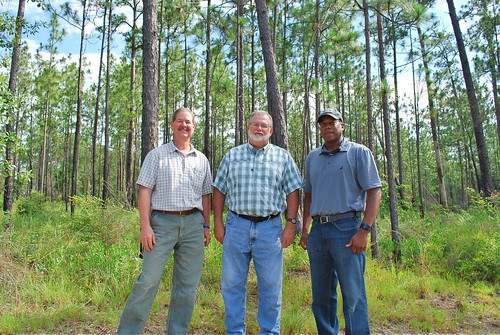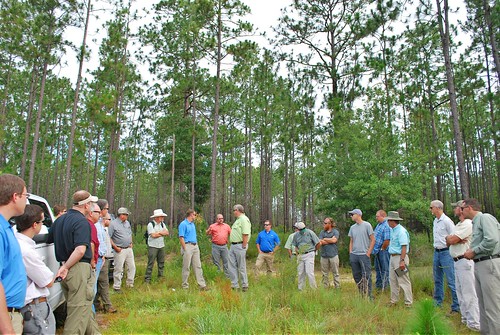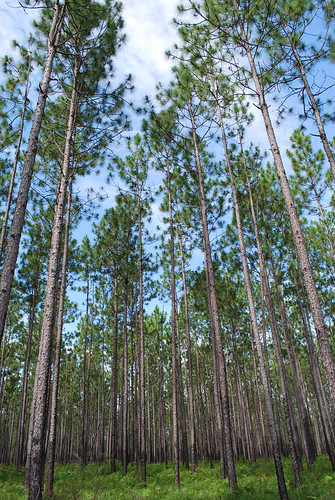
(Pictured left to right) Jimmy Bullock with the Resource Management Service, Andrew Schock with The Conservation Fund and NRCS Alabama State Conservationist Ben Malone stand in one project area for the Coastal Headwaters Forest.
It takes time, patience and a committed partnership, but seeing thriving forests of longleaf pine trees return to Alabama’s Gulf Coast is well-worth the wait.
Longleaf pine forests once dominated the American Southeast, stretching across 90 million acres. A stronghold of the region’s environment and economy, longleaf was an essential building material used during the American Industrial Revolution. Today, only four percent of the original forests remain standing.
The Natural Resources Conservation Service (NRCS) in Alabama is working with groups to revive this strong and resilient wood, while also providing environmental benefits for the Gulf Coastal Plain’s wildlife and water.
Through the Regional Conservation Partnership Program (RCPP), NRCS is collaborating with The Conservation Fund (TCF), Resource Management Service (RMS), and many others on the Coastal Headwaters Forest, on a working forest project in Alabama and Florida. The first RCPP phase is underway in Florida. The second phase in Alabama will use $5.1 million from RCPP, leveraged by $5.1 million in private and public partner funding, to protect and restore the longleaf pine ecosystem on 4,500 acres.
The Coastal Headwaters Forest Partnership offers a needed solution, bringing partners and resources together to conserve and restore longleaf pine habitat on private lands, where the majority of southeastern forest land is located.
NRCS will place a conservation easement on property in Alabama, providing protection and preventing land fragmentation. By preventing the forests from becoming fragmented into smaller parcels, the lands retain their ability to provide space for wildlife to live and migrate, as well as filter our water and remove CO2 from the air is compromised. The private landowner, RMS, will retain ownership, restore longleaf pine, keep the land on the tax rolls, and continue its forestry work that benefits the regional economy.

Several partners attended a tour of the RCPP project area in the Coastal Headwaters Forest in Baldwin County, Alabama this summer.
During a site tour held in late June, several partners, including the Longleaf Alliance, Alabama Wildlife Federation and the E. O. Wilson Foundation joined NRCS, The Conservation Fund and RMS in visiting key areas that will see direct benefits of restoring the longleaf pine ecosystem.
“Restoring longleaf pine in Alabama’s Gulf Coastal Plain will preserve two major coastal river systems, Perdido and Escambia Rivers, in the Gulf Coastal Plain and protect habitat for the threatened gopher tortoise and approximately 250 other species related to longleaf pine habitat,” said NRCS Alabama State Conservationist, Ben Malone.
The private landowner’s commitment to longleaf pine conservation and restoration is critical to regional wildlife and water protection. The keystone species include the gopher tortoise, cotton-tailed rabbit and indigo snake. The project will also help protect and filter the many miles of streams flowing to the Perdido River and into the Gulf of Mexico.
“With the RCPP grant, dozens of public and private partners are ready to meet, educate, make a change and be a model for restoring longleaf pine in Alabama’s Gulf Coastal Plain. The Coastal Headwaters Forests Partnership will make a difference in reversing the decline in longleaf pine and show large commercial timberland owners that longleaf pine can be a viable economic resource,” The Conservation Fund’s Andrew Schock said.
The Coastal Headwaters Forest Partnership will advance the goals of America’s Longleaf Restoration Initiative—a collaborative, public-private effort to restore the threatened longleaf ecosystems across eight million acres by 2025.
The Longleaf Pine Ecosystem is one of several “critical conservation areas”—or focal areas—for the RCPP, and this project will build on other RCPP longleaf efforts in the Southeast, along with other federal, state and private investments being made throughout a 9-state region to restore longleaf pine.
Created by the 2014 Farm Bill, RCPP investments of nearly $600 million have already driven 199 partner-led projects, including four projects in Alabama. The program leverages local leadership to establish partnerships that can include private companies, local and tribal governments, universities, non-profits and other non-government partners to work with farmers, ranchers and forest landowners on landscape-and watershed-scale conservation solutions that work best for their region.

This is an established longleaf pine stand located in the Coastal Headwaters Forest just off the Gulf Coast in Alabama.
No comments:
Post a Comment
Note: Only a member of this blog may post a comment.